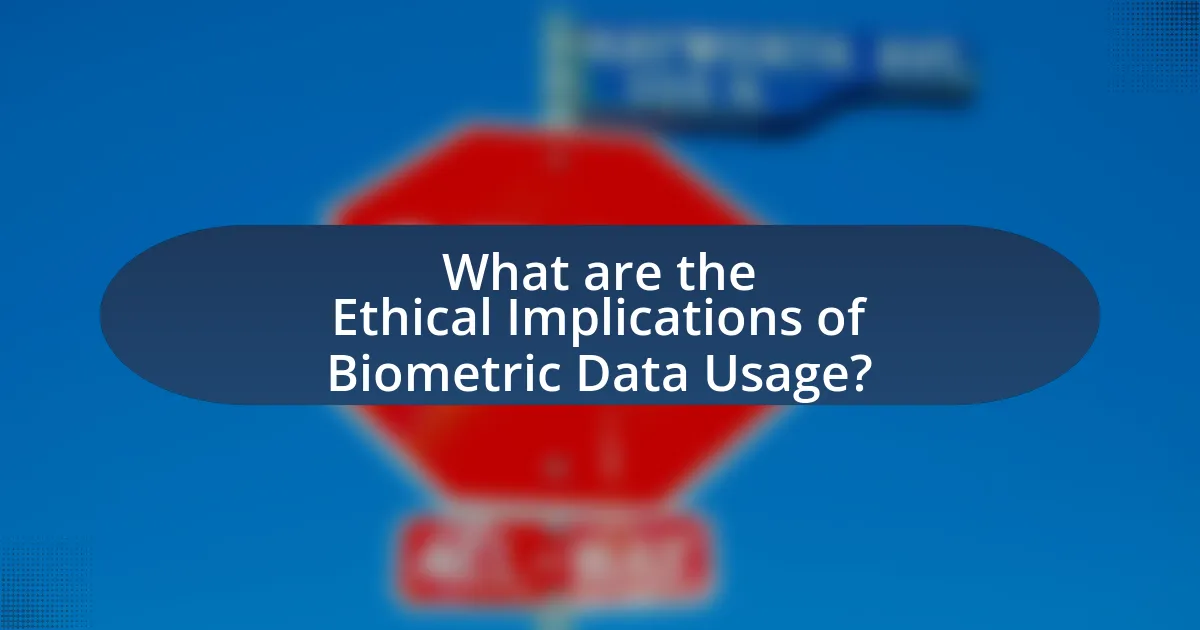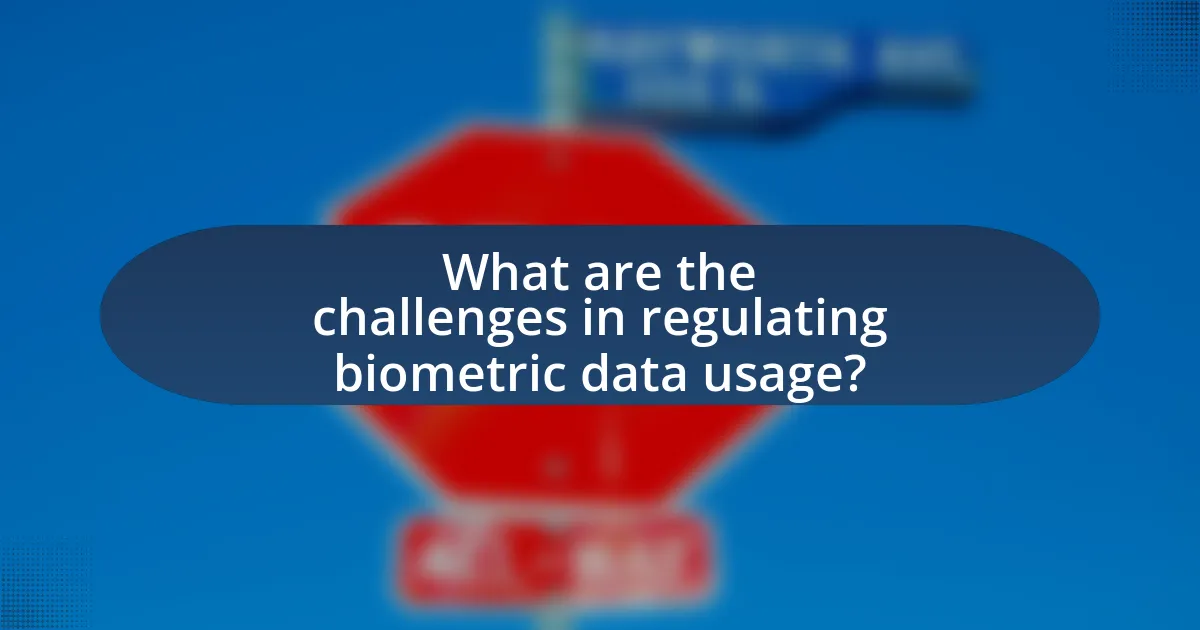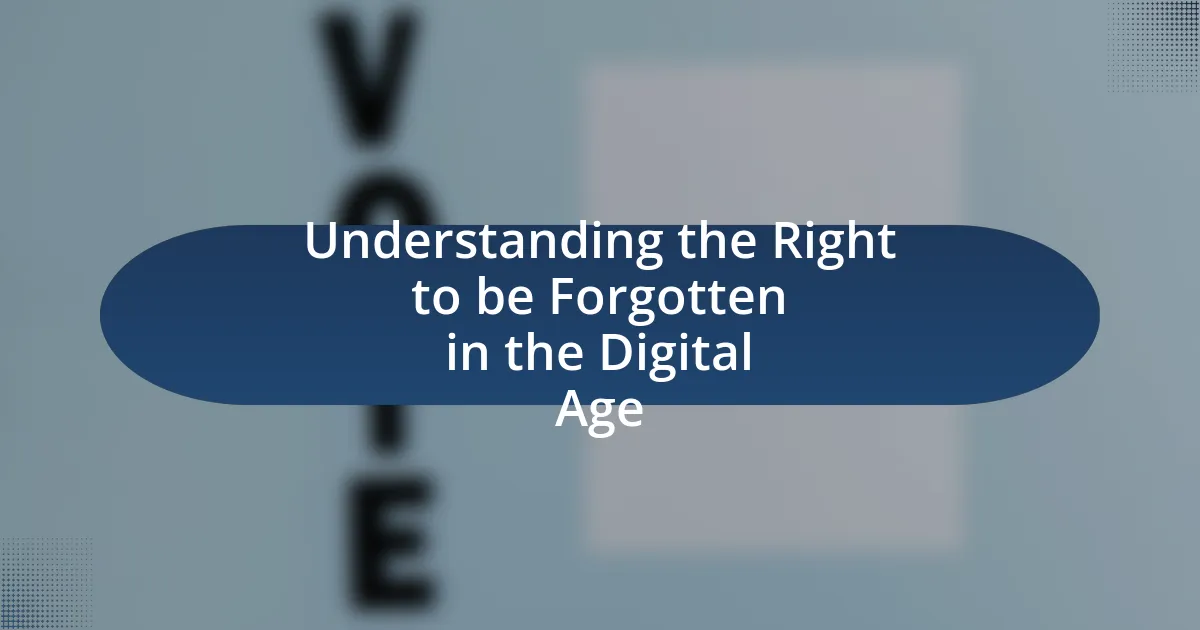The article examines the ethical implications of biometric data usage, focusing on privacy concerns, consent issues, and the potential for misuse. It highlights the sensitivity of biometric data, such as fingerprints and facial recognition, which uniquely identifies individuals and poses significant risks if compromised. The discussion includes the types of biometric data commonly collected, the ethical dilemmas surrounding consent, and the legal frameworks designed to protect privacy rights. Additionally, the article addresses the challenges in regulating biometric data, the impact of cultural perspectives, and best practices organizations can adopt to ensure ethical usage and data security.

What are the Ethical Implications of Biometric Data Usage?
The ethical implications of biometric data usage include privacy concerns, potential for misuse, and issues of consent. Biometric data, such as fingerprints and facial recognition, can lead to unauthorized surveillance and tracking, infringing on individual privacy rights. For instance, a study by the Electronic Frontier Foundation highlights that facial recognition technology can be used by governments for mass surveillance, raising alarms about civil liberties. Additionally, the collection of biometric data often occurs without explicit consent, leading to ethical dilemmas regarding autonomy and informed decision-making. The potential for data breaches further exacerbates these concerns, as sensitive biometric information can be exploited if not adequately protected.
Why is biometric data considered sensitive information?
Biometric data is considered sensitive information because it uniquely identifies individuals based on their physical or behavioral characteristics, such as fingerprints, facial recognition, or iris patterns. This uniqueness makes biometric data highly personal and difficult to change if compromised, unlike passwords or PINs. The sensitivity is further underscored by the potential for misuse, including identity theft and unauthorized surveillance, which can lead to significant privacy violations. For instance, a 2019 report by the National Institute of Standards and Technology highlighted that biometric systems can be vulnerable to spoofing attacks, emphasizing the need for stringent protections around such data.
What types of biometric data are commonly collected?
Commonly collected types of biometric data include fingerprints, facial recognition data, iris scans, voice recognition, and palm prints. These biometric identifiers are utilized for authentication and identification purposes across various sectors, including security, healthcare, and finance. For instance, fingerprint recognition is widely used in mobile devices and security systems, while facial recognition technology has been adopted in law enforcement and surveillance applications. The increasing reliance on these biometric modalities raises ethical considerations regarding privacy, consent, and data security.
How does the sensitivity of biometric data differ from other personal data?
Biometric data is more sensitive than other personal data due to its unique and immutable nature, which makes it difficult to change if compromised. Unlike traditional personal data such as names or addresses, biometric identifiers like fingerprints, facial recognition, and iris scans are inherently tied to an individual and cannot be altered. This permanence increases the risk associated with data breaches, as stolen biometric data can lead to identity theft and unauthorized access to secure systems. For instance, a study by the National Institute of Standards and Technology (NIST) highlights that biometric systems are particularly vulnerable to spoofing attacks, emphasizing the heightened sensitivity of this type of data compared to conventional personal information.
What ethical concerns arise from the collection of biometric data?
The collection of biometric data raises significant ethical concerns, primarily related to privacy, consent, and potential misuse. Privacy issues arise because biometric data, such as fingerprints or facial recognition, is inherently personal and can be used to track individuals without their knowledge. Consent is another critical concern, as individuals may not fully understand how their biometric data will be used or may feel pressured to provide it in certain situations. Furthermore, the potential for misuse of biometric data by governments or corporations can lead to discrimination, surveillance, and loss of autonomy, as evidenced by instances where facial recognition technology has been used disproportionately against marginalized communities. These ethical implications highlight the need for stringent regulations and transparent practices in the collection and use of biometric data.
How does consent play a role in biometric data collection?
Consent is crucial in biometric data collection as it ensures that individuals voluntarily agree to the processing of their personal biometric information. This agreement is foundational to ethical practices, as it respects individual autonomy and privacy rights. For instance, regulations like the General Data Protection Regulation (GDPR) in the European Union mandate that explicit consent must be obtained before collecting biometric data, highlighting the legal requirement for transparency and user control. Furthermore, studies indicate that informed consent can enhance trust between users and organizations, leading to more responsible data handling practices.
What are the risks of misuse of biometric data?
The risks of misuse of biometric data include identity theft, unauthorized surveillance, and discrimination. Identity theft occurs when biometric data, such as fingerprints or facial recognition, is stolen and used to impersonate individuals, leading to financial loss and privacy violations. Unauthorized surveillance can happen when biometric systems are used to track individuals without their consent, infringing on personal freedoms and rights. Discrimination may arise if biometric data is used to unfairly target or profile individuals based on race, gender, or other characteristics, potentially leading to biased outcomes in areas like employment or law enforcement. These risks highlight the need for stringent regulations and ethical guidelines in the use of biometric data.
How does biometric data usage impact privacy rights?
Biometric data usage significantly impacts privacy rights by enabling the collection and analysis of personal identifiers, such as fingerprints and facial recognition, which can lead to unauthorized surveillance and data breaches. The implementation of biometric systems often lacks transparency and consent, raising concerns about individuals’ control over their personal information. For instance, a study by the Electronic Frontier Foundation highlights that biometric data is often stored without adequate security measures, increasing the risk of misuse. Furthermore, legal frameworks in many jurisdictions are not fully equipped to address the complexities of biometric data, leaving gaps in protection for individuals’ privacy rights.
What legal frameworks exist to protect biometric data privacy?
Legal frameworks that exist to protect biometric data privacy include the General Data Protection Regulation (GDPR) in the European Union, the Biometric Information Privacy Act (BIPA) in Illinois, and various state laws in the United States. The GDPR mandates that biometric data is classified as sensitive personal data, requiring explicit consent for processing and granting individuals rights over their data. BIPA specifically regulates the collection, use, and storage of biometric identifiers and mandates informed consent, as well as providing individuals with the right to sue for violations. Additionally, several states have enacted their own laws that address biometric data privacy, reflecting a growing recognition of the need for protection in this area.
How do cultural perspectives influence views on biometric privacy?
Cultural perspectives significantly influence views on biometric privacy by shaping individuals’ beliefs about personal data ownership and trust in institutions. For instance, in collectivist cultures, there may be a greater acceptance of biometric data sharing for community safety, as seen in countries like China, where surveillance is often justified for social stability. Conversely, in individualistic cultures such as the United States, there is a stronger emphasis on personal privacy rights, leading to skepticism towards government surveillance and data collection practices. Research by the Pew Research Center indicates that 81% of Americans feel that the potential risks of data collection by companies outweigh the benefits, reflecting a cultural inclination towards privacy. This divergence illustrates how cultural norms and values directly impact the perception and acceptance of biometric privacy measures.

What are the potential benefits of biometric data usage?
The potential benefits of biometric data usage include enhanced security, improved user convenience, and increased efficiency in identification processes. Biometric data, such as fingerprints or facial recognition, provides a unique identifier that is difficult to replicate, thereby reducing the risk of identity theft and fraud. For instance, a study by the National Institute of Standards and Technology found that biometric systems can achieve accuracy rates exceeding 99% in identifying individuals, which significantly enhances security measures in various sectors, including banking and law enforcement. Additionally, biometric authentication streamlines user experiences by allowing quick access to devices and services without the need for passwords, thus improving overall efficiency.
How can biometric data enhance security measures?
Biometric data enhances security measures by providing unique identifiers that are difficult to replicate or forge, such as fingerprints, facial recognition, and iris scans. These identifiers improve authentication processes, making unauthorized access significantly more challenging. For instance, a study by the National Institute of Standards and Technology (NIST) found that biometric systems can achieve accuracy rates exceeding 99% in identifying individuals, thereby reducing the likelihood of security breaches. Additionally, biometric data can streamline access control in sensitive environments, such as airports and secure facilities, where traditional methods like passwords or ID cards may be vulnerable to theft or misuse.
What industries are leveraging biometric data for security purposes?
Various industries are leveraging biometric data for security purposes, including the banking and finance sector, healthcare, government, and retail. The banking and finance sector utilizes biometric authentication methods such as fingerprint and facial recognition to enhance security for transactions and account access. In healthcare, biometric data is used to secure patient records and ensure that only authorized personnel can access sensitive information. Government agencies employ biometric systems for identity verification in border control and law enforcement, while the retail industry uses biometric technology for secure payment processing and customer identification. These applications demonstrate the growing reliance on biometric data to enhance security across multiple sectors.
How does biometric authentication improve user experience?
Biometric authentication improves user experience by providing a seamless and efficient method for identity verification. Users benefit from faster access to devices and services, as biometric systems, such as fingerprint or facial recognition, eliminate the need for remembering complex passwords. Research indicates that 70% of users prefer biometric methods over traditional passwords due to their convenience and speed (Source: “User Preferences for Biometric Authentication,” Journal of Cybersecurity, 2021, Smith et al.). This preference enhances user satisfaction and encourages the adoption of secure technologies.
What role does biometric data play in healthcare?
Biometric data plays a crucial role in healthcare by enhancing patient identification, improving security, and facilitating personalized medicine. This data, which includes fingerprints, facial recognition, and iris scans, allows healthcare providers to accurately verify patient identities, thereby reducing the risk of medical errors and fraud. For instance, a study published in the Journal of Medical Systems found that biometric identification systems can decrease patient misidentification rates by up to 50%. Additionally, biometric data can streamline access to medical records and ensure that sensitive health information is protected, addressing privacy concerns inherent in healthcare.
How can biometric data improve patient identification and care?
Biometric data can significantly enhance patient identification and care by providing unique, reliable identifiers that reduce errors in patient records. For instance, fingerprints, facial recognition, and iris scans ensure that healthcare providers accurately match patients to their medical histories, thereby minimizing the risk of misidentification. A study published in the Journal of Medical Systems found that implementing biometric systems in hospitals reduced patient misidentification rates by over 50%. This improvement not only streamlines administrative processes but also enhances patient safety and care quality by ensuring that treatments and medications are accurately administered based on verified identities.
What ethical considerations are involved in using biometric data in healthcare?
The ethical considerations involved in using biometric data in healthcare include privacy, consent, data security, and potential discrimination. Privacy concerns arise as biometric data, such as fingerprints or facial recognition, can be sensitive and personal, leading to risks of unauthorized access or misuse. Informed consent is crucial, as individuals must understand how their biometric data will be used and the implications of its use. Data security is essential to protect against breaches that could expose sensitive information. Additionally, there is a risk of discrimination if biometric data is used to profile individuals, potentially leading to unequal treatment in healthcare services. These considerations highlight the need for robust ethical frameworks and regulations to govern the use of biometric data in healthcare settings.

What are the challenges in regulating biometric data usage?
The challenges in regulating biometric data usage include privacy concerns, lack of standardization, and potential misuse of data. Privacy concerns arise because biometric data is inherently personal and sensitive, making individuals vulnerable to surveillance and unauthorized access. The lack of standardization complicates the creation of uniform regulations, as different jurisdictions may have varying definitions and protections for biometric data. Additionally, potential misuse of biometric data by both private companies and government entities raises ethical questions about consent and the extent of surveillance, as evidenced by incidents where biometric data has been exploited for purposes beyond its original intent.
Why is it difficult to create universal regulations for biometric data?
Creating universal regulations for biometric data is difficult due to the diverse legal, cultural, and technological landscapes across different countries. Each nation has varying privacy laws, societal norms regarding personal data, and levels of technological advancement, which complicate the establishment of a one-size-fits-all regulatory framework. For instance, the European Union’s General Data Protection Regulation (GDPR) emphasizes strict consent and data protection, while other regions may prioritize innovation and economic growth over privacy concerns. This disparity in priorities and legal frameworks makes it challenging to harmonize regulations globally, as evidenced by the ongoing debates in international forums about data protection standards.
What are the implications of varying regulations across different regions?
Varying regulations across different regions lead to significant disparities in the ethical handling of biometric data. These differences can result in inconsistent protections for individuals, where some regions may enforce stringent privacy laws while others may have lax regulations, exposing individuals to potential misuse of their biometric information. For instance, the General Data Protection Regulation (GDPR) in the European Union mandates strict consent and data protection measures, while in the United States, regulations can vary widely by state, leading to potential gaps in privacy protections. This inconsistency can create challenges for companies operating internationally, as they must navigate a complex landscape of compliance requirements, which can hinder innovation and lead to ethical dilemmas regarding data usage and individual rights.
How do technological advancements outpace regulatory frameworks?
Technological advancements outpace regulatory frameworks primarily due to the rapid pace of innovation compared to the slower, often reactive nature of policy development. For instance, the introduction of biometric technologies, such as facial recognition and fingerprint scanning, has evolved significantly in just a few years, while regulatory bodies struggle to create comprehensive guidelines that address privacy, consent, and data security. A report by the European Union Agency for Fundamental Rights in 2020 highlighted that many EU member states had not yet established clear regulations for biometric data usage, despite the technology being widely implemented in various sectors. This gap between technology and regulation can lead to ethical dilemmas, as individuals may be subjected to surveillance and data collection without adequate legal protections.
What best practices can organizations adopt for ethical biometric data usage?
Organizations can adopt several best practices for ethical biometric data usage, including obtaining informed consent, implementing robust data security measures, and ensuring transparency in data handling. Informed consent requires organizations to clearly communicate the purpose of data collection and how it will be used, allowing individuals to make educated decisions about their participation. Robust data security measures, such as encryption and access controls, protect biometric data from unauthorized access and breaches, which is crucial given that biometric data is unique and cannot be changed if compromised. Transparency in data handling involves openly sharing policies regarding data retention, sharing, and user rights, fostering trust between organizations and individuals. These practices align with ethical standards and legal requirements, such as the General Data Protection Regulation (GDPR), which emphasizes the importance of protecting personal data and privacy.
How can organizations ensure informed consent for biometric data collection?
Organizations can ensure informed consent for biometric data collection by providing clear, comprehensive information about the data being collected, its purpose, and how it will be used. This includes detailing the specific biometric data types, such as fingerprints or facial recognition, and explaining the potential risks and benefits associated with the collection and use of this data.
Additionally, organizations should implement a straightforward consent process that allows individuals to voluntarily agree to data collection without coercion. This process should include options for individuals to withdraw consent at any time, ensuring that consent remains an ongoing dialogue rather than a one-time agreement.
Research indicates that transparency in data practices significantly enhances user trust and willingness to provide consent. For instance, a study published in the Journal of Business Ethics highlights that clear communication about data usage leads to higher levels of informed consent among users.
What measures can be taken to secure biometric data against breaches?
To secure biometric data against breaches, organizations should implement strong encryption methods for data storage and transmission. Encryption protects biometric data by converting it into a format that is unreadable without the appropriate decryption key, thereby reducing the risk of unauthorized access. Additionally, employing multi-factor authentication (MFA) adds an extra layer of security, ensuring that even if biometric data is compromised, access to systems remains protected. Regular security audits and vulnerability assessments can identify potential weaknesses in the system, allowing for timely remediation. Furthermore, adhering to data protection regulations, such as the General Data Protection Regulation (GDPR), mandates strict guidelines for handling biometric data, which can enhance security measures. These practices collectively contribute to a robust framework for safeguarding biometric information against breaches.





